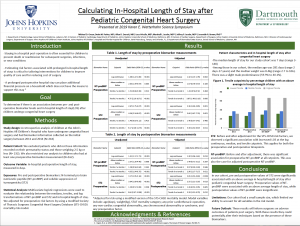On Wednesday, May 22nd Dartmouth undergraduate scientists presented their work at the Wetterhahn Symposium in the Class of 1978 Life Sciences Center. Among them were interns from Dr. Jeremiah Brown's lab who spent the winter and spring terms studying clinical outcomes from acute myocardial infarction (AMI) and congenital heart surgery.
WISP interns, Sathvika Korandla '22 and Kate Miller '22 presented their collaborative work on "Systemizing annotation 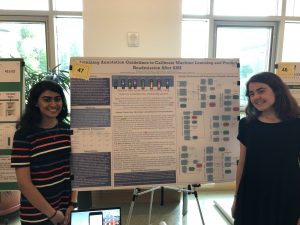 guidelines to calibrate machine learning models and predict readmission after AMI." The interns utilized, analyzed and organized a set of written guidelines. These guidelines were crafted over several years by Dr. Brown's lab in collaboration with Vanderbilt University and the University of Utah to help make careful annotations in clinical notes regarding social risk factors such as living alone, depression, and instrumental support.
guidelines to calibrate machine learning models and predict readmission after AMI." The interns utilized, analyzed and organized a set of written guidelines. These guidelines were crafted over several years by Dr. Brown's lab in collaboration with Vanderbilt University and the University of Utah to help make careful annotations in clinical notes regarding social risk factors such as living alone, depression, and instrumental support. 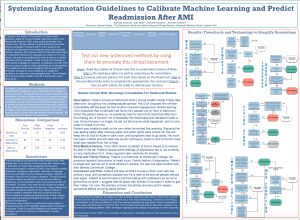 Annotations sets are adjudicated and implemented to calibrate the natural language processing tool, Moonstone. Sathvika and Kate worked to remove ambiguity from the guidelines and add a more systematic approach to annotations.They presented this work along with an app developed by Sathvika to help future researchers work through clinical annotations. They hope to continue their work next term.
Annotations sets are adjudicated and implemented to calibrate the natural language processing tool, Moonstone. Sathvika and Kate worked to remove ambiguity from the guidelines and add a more systematic approach to annotations.They presented this work along with an app developed by Sathvika to help future researchers work through clinical annotations. They hope to continue their work next term.
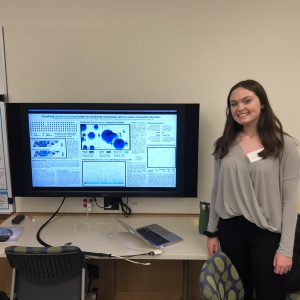 Catherine Parnell '22, also a WISP intern, worked on a different aspect of the AMI research by attempting to uncover a more visual representation of machine learning as it is used in clinical research. Her work on "Visualizing machine learning models for predicting readmission after an acute myocardial infarction" was featured on a digital poster that animated machine learning tools. Her work was enhanced by a keen understanding of R, as well as an expanding knowledge of the inner-workings of machine learning models, such as random forest and three widely used regularization methods. The animations on her poster made it easy to identify what regularization does to coefficients in a clinical model and helped to illuminate the creation of decision trees within the random forest model. It also introduced the comparison of receiver operator curves by layering them on top of one another with animation which offered a clearer visual comparison than one side-by-side. She hopes to continue with Dr. Brown's lab, and dive deeper into machine learning and data visualization.
Catherine Parnell '22, also a WISP intern, worked on a different aspect of the AMI research by attempting to uncover a more visual representation of machine learning as it is used in clinical research. Her work on "Visualizing machine learning models for predicting readmission after an acute myocardial infarction" was featured on a digital poster that animated machine learning tools. Her work was enhanced by a keen understanding of R, as well as an expanding knowledge of the inner-workings of machine learning models, such as random forest and three widely used regularization methods. The animations on her poster made it easy to identify what regularization does to coefficients in a clinical model and helped to illuminate the creation of decision trees within the random forest model. It also introduced the comparison of receiver operator curves by layering them on top of one another with animation which offered a clearer visual comparison than one side-by-side. She hopes to continue with Dr. Brown's lab, and dive deeper into machine learning and data visualization.
Michael Green '21, presented his work on the ability of novel cardiac biomarkers to better predict in-hospital length of stay following pediatric congenital heart surgery. Michael applied the validated Society of Thoracic Surgeons Congenital Heart Surgery Database STS-CHSD mortality risk model to the cohort and augmented the model with the biomarkers. Michael found that there was a significant association of pre- and postoperative levels of ST2 with longer than average in-hospital lengths of stay for children undergoing congenital heart surgery. These findings will help inform surgeons on the appropriate timing of surgery, alternatives and discharge planning. 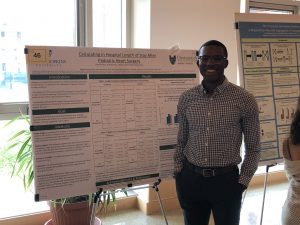
Michael was awarded the E.E. Just Fellowship to continue working with the Brown lab, and he plans to explore various environmental and socioeconomic factors that may be associated with pediatric clinical outcomes following congenital heart surgery.
